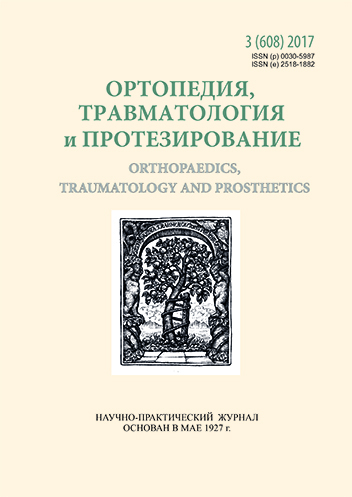Development of distal metaepiphysis of the femur in conditions of temporary bilateral blocking of the growth zone (experimental study)
DOI:
https://doi.org/10.15674/0030-59872017348-53Keywords:
experimental research, growth zone, temporary bilateral blocking, secondary deformationsAbstract
The use of minimally invasive methods of blocking the long bones growth zone to eliminate the difference in the length of the lower extremities in children is a modern and promising direction. The technique of temporary bilateral blocking of growth zone with screw plates has potential advantages, however, the formation of secondary frontal deformations remains an insufficiently studied issue.
Objective: to evaluate the formation of the distal metaepiphysis of the femur in conditions of temporary bilateral blocking of growth zone with plates of different types.
Methods: temporary bilateral blocking of the distal growth zone of the right femur is performed in 10 white rabbits at the age of 8 weeks and weighing (1.8 ± 0.2) kg. Animals were divided into groups: 1 (5 rabbits) — non-blocking plates were used, 2 (5) — blocked. An overview radiograph of the lower extremities of the animals was performed immediately after the operation after 3, 5 and 7 weeks. The radiographs were evaluated according to the Paley protocol, mLDFA, PSA, DSA, distance between the «wires-growth zone» in three zones (medial, middle and lateral) were determined.
Results: the inhibition of longitudinal growth of growth zone was revealed when both types of plates were used. There were no differences in the angular parameters of the distal femur (mLDFA) between the groups. In group 1, the PSA and DSA values increased significantly during the growth process (p < 0.05), in group 2 — remained unchanged for the entire follow-up period. A significant increase in the «spine-growth zone» distance on the limb in question was noted in group 1 rabbits in the middle zone in dynamics.
Conclusions: temporary bilateral blocking growth zone using both types of plates with screws leads to inhibition of its longitudinal growth. During blocking, there were no secondary deformations of the distal metaepiphysis of the femur. Slight growth of the distal growth zone, especially in the middle zone, indicates a residual growth in temporary bilateral blocking conditions with non-blocking plates.References
- Ghanem I. Karam JA, Widmann RF. Surgical epiphysiodesis indications and techniques: update. Curr Opin Pediatr. 2011;23(1):53-9. doi: 10.1097/MOP.0b013e32834231b3.
- Burnei G, Vlad C, Gavriliu S, Georgescu I, Hodorogea D, Pârvan A, Burnei C, El Nayef T, Drăghici I. Upper and lower limb length equalization: diagnosis, limb lengthening and curtailment, epiphysiodesis. Rom J Intern Med. 2012;50(1):43-9.
- Ilharreborde B, Gaumetou E, Souchet P, Fitoussi F, Presedo A, Penneçot GF, Mazda K. Efficacy and late complications of percutaneous epiphysiodesis using transphyseal screws. J Bone Joint Surg Br. 2012;94(2):270-5. doi: 10.1302/0301-620X.94B2.27470.
- Pendleton AM, Stevens PM, Hung M. Guided growth for the treatment of moderate leg-length discrepancy. Orthopedics. 2013;36(5):e575-80. doi: 10.3928/01477447-20130426-18.
- Stewart D, Cheema A, Szalay EA. Dual 8-plate technique is not as effective as ablation for epiphysiodesis about the knee. J Pediatr Orthop. 2013;33(8):843-6. doi: 10.1097/BPO.0b013e3182a11d23.
- Gaumétou E, Mallet C, Souchet P, Mazda K, Ilharreborde B. Poor efficiency of eight-plates in the treatment of lower limb discrepancy. J Pediatr Orthop. 2016;36(7):715-9. doi: 10.1097/BPO.0000000000000518.
- Ross TK, Zionts LE. Comparison of different methods used to inhibit physeal growth in a rabbit model. Clin Orthop Relat Res. 1997;340:236-43.
- Widmann RF, Amaral TD, Yildiz C, Yang X, Bostrom M. Percutaneous radiofrequency epiphysiodesis in a rabbit model. A pilot study. Clin Orthop Relat Res. 2010;468(7):1943-8. doi: 10.1007/s11999-010-1286-8.
- Gottliebsen M, Mоller-Madsen B, Stоdkilde-Jоrgensen H, Rahbek Controlled O. longitudinal bone growth by temporary tension band plating: an experimental study. Bone Joint J. 2013;95-B(6):855-60. doi: 10.1302/0301-620X.95B6.29327.
- Komur B, Coskun M, Komur AA, Oral A. Permanent and temporary epiphysiodesis: an experimental study in a rabbit model. Acta Orthop Traumatol Turc. 2013;47(1):48-54.
- Hall-Craggs EC, Lawrence CA. The effect of epiphysial stapling on growth in length of the rabbits tibia and femur. J Bone Joint Surg Br. 1969;51(2):359-65.
- Paley D, Pfeil J. Principles of deformity correction around the knee. Orthopade. 2000;29(1):18-38.
- Filipenko VA, Miteleva ZM, Petrenko DE, et al. Theoretical substantiation of the selection of the leg of cementless endoprosthetic of the hip joint. Bulletin of Orthopedics, Traumatology and Prosthetics. 2003;2:32–36. (in Ukrainian)
Downloads
How to Cite
Issue
Section
License
Copyright (c) 2017 Sergey Khmyzov, Victor Rokutov, Dmytro Iershov

This work is licensed under a Creative Commons Attribution 4.0 International License.
The authors retain the right of authorship of their manuscript and pass the journal the right of the first publication of this article, which automatically become available from the date of publication under the terms of Creative Commons Attribution License, which allows others to freely distribute the published manuscript with mandatory linking to authors of the original research and the first publication of this one in this journal.
Authors have the right to enter into a separate supplemental agreement on the additional non-exclusive distribution of manuscript in the form in which it was published by the journal (i.e. to put work in electronic storage of an institution or publish as a part of the book) while maintaining the reference to the first publication of the manuscript in this journal.
The editorial policy of the journal allows authors and encourages manuscript accommodation online (i.e. in storage of an institution or on the personal websites) as before submission of the manuscript to the editorial office, and during its editorial processing because it contributes to productive scientific discussion and positively affects the efficiency and dynamics of the published manuscript citation (see The Effect of Open Access).














